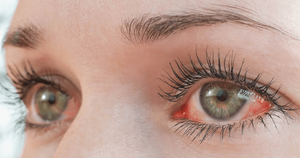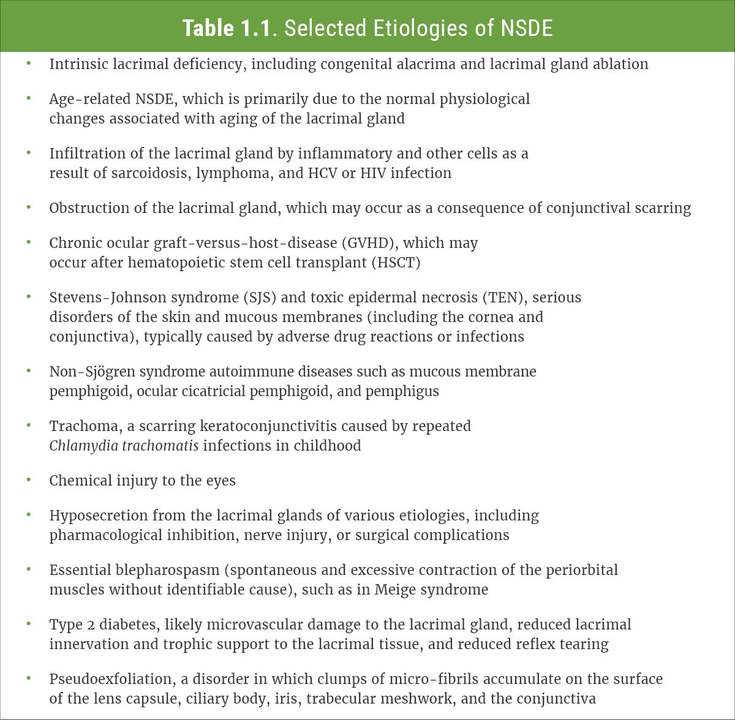Etiology and Classification
Types and Causes of Dry Eye Syndrome
Dry Eye Syndrome (DES) encompasses a large number of distinct and related etiologies; however, these can broadly be divided into two groups: aqueous tear deficiency DES (also known as aqueous tear deficient dry eye, or ADDE) and evaporative DES (also known simply as evaporative dry eye, or EDE). As the names suggest, ADDE covers conditions which affect the function of lacrimal glands, while EDE includes both lid-related etiologies (meibomian gland dysfunction, blink-related disorders, etc.) and ocular surface-related etiologies (e.g., mucin and contact lens-related disorders). The validity of ADDE and EDE as distinct etiological classes was endorsed by TFOS DEWS II; however, the classification subcommittee also recognized that in most cases, DED exists on a spectrum between ADDE and EDE, with many patients exhibiting a combination of these two types – in other words, the two categories are not mutually exclusive. The management approach for…
To continue reading
Log in or register to continue reading. It's free!
OR
By signing up to create an account, I accept Healio's Terms of Use and Privacy Policy.
Types and Causes of Dry Eye Syndrome
Dry Eye Syndrome (DES) encompasses a large number of distinct and related etiologies; however, these can broadly be divided into two groups: aqueous tear deficiency DES (also known as aqueous tear deficient dry eye, or ADDE) and evaporative DES (also known simply as evaporative dry eye, or EDE). As the names suggest, ADDE covers conditions which affect the function of lacrimal glands, while EDE includes both lid-related etiologies (meibomian gland dysfunction, blink-related disorders, etc.) and ocular surface-related etiologies (e.g., mucin and contact lens-related disorders). The validity of ADDE and EDE as distinct etiological classes was endorsed by TFOS DEWS II; however, the classification subcommittee also recognized that in most cases, DED exists on a spectrum between ADDE and EDE, with many patients exhibiting a combination of these two types – in other words, the two categories are not mutually exclusive. The management approach for each patient primarily depends on the specific combination of elements that they exhibit.
Within the category of ADDE, two sub-classes are recognized: Sjögren syndrome dry eye (SSDE) and non-Sjögren syndrome dry eye (NSDE). Sjögren syndrome is discussed in Comorbidities, but its defining characteristic is systemic autoimmune inflammation. Numerous conditions, including intrinsic disorders, infections and injury, may cause NSDE; see Table 1-1 for more information.
The category of EDE includes two major etiological subcategories: EDE as a result of evaporative barrier functional loss (i.e., lid-related EDE) and EDE as a result of reduced ocular surface wettability (i.e., ocular surface-related EDE). Conditions associated with EDE are shown in Table 1-2.
While DES often starts off as ADDE or EDE, as the disease progresses, elements of both types tend to appear. Some hybrid subtypes of DES (i.e., those with both ADDE and EDE elements) are shown in Table 1-3.
It is important to note that, formally defined, DES must exhibit both signs (i.e., objective evidence of the disease) and symptoms (i.e., subjective patient-reported experiences). Patients with symptoms but no signs may have pre-clinical ocular surface disease or neuropathic pain, while those with no symptoms may have poor corneal sensitivity or prodromal signs consistent with an increased risk of DES.
Finally, it should be noted that other classification schemes have been proposed. For example, the Cornea, External Disease and Refractive Surgery Society (CEDARS) divided DES (and associated tear film disorders for which CEDARS uses the collective term DTS) into four categories: Aqueous Deficiency, Blepharitis/MGD (with or without an evaporative component), Goblet Cell/Mucin deficiency and Exposure-Related DTS (Figure 1-2). CEDARS also proposed a fifth category called “DTS co-conspirators” for tear film and ocular conditions that mimic or exacerbate DES, including superior limbic keratoconjunctivitis, medicamentosa, Thygeson superficial punctate keratitis, mucus fishing syndrome, contact lens-related toxicity, chemical toxicity, allergic/atopic conjunctivitis, conjunctivochalasis, floppy lid syndrome and corneal hyperalgesia.

References
- Bron AJ, de Paiva CS, Chauhan SK, et al. TFOS DEWS II pathophysiology report. Ocul Surf. 2017;15(3):438-510.
- Chan C. Dry Eye : A Practical Approach. Springer; 2015.






